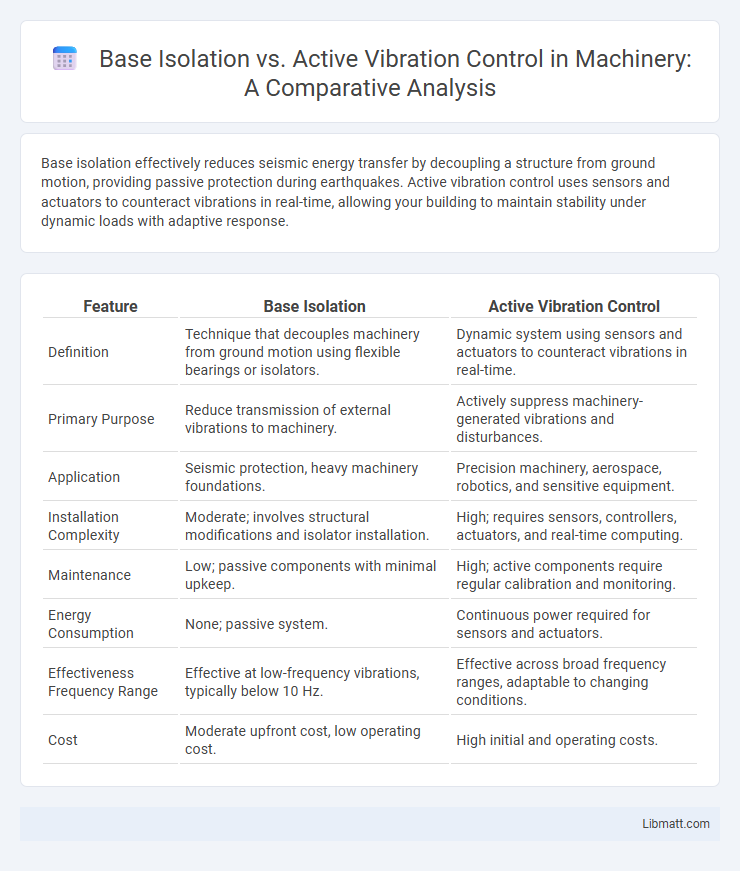Base isolation effectively reduces seismic energy transfer by decoupling a structure from ground motion, providing passive protection during earthquakes. Active vibration control uses sensors and actuators to counteract vibrations in real-time, allowing your building to maintain stability under dynamic loads with adaptive response.
Table of Comparison
| Feature | Base Isolation | Active Vibration Control |
|---|---|---|
| Definition | Technique that decouples machinery from ground motion using flexible bearings or isolators. | Dynamic system using sensors and actuators to counteract vibrations in real-time. |
| Primary Purpose | Reduce transmission of external vibrations to machinery. | Actively suppress machinery-generated vibrations and disturbances. |
| Application | Seismic protection, heavy machinery foundations. | Precision machinery, aerospace, robotics, and sensitive equipment. |
| Installation Complexity | Moderate; involves structural modifications and isolator installation. | High; requires sensors, controllers, actuators, and real-time computing. |
| Maintenance | Low; passive components with minimal upkeep. | High; active components require regular calibration and monitoring. |
| Energy Consumption | None; passive system. | Continuous power required for sensors and actuators. |
| Effectiveness Frequency Range | Effective at low-frequency vibrations, typically below 10 Hz. | Effective across broad frequency ranges, adaptable to changing conditions. |
| Cost | Moderate upfront cost, low operating cost. | High initial and operating costs. |
Understanding Seismic Protection Systems
Base isolation systems reduce seismic forces by decoupling a structure from ground motion through flexible bearings or pads, significantly lowering structural acceleration during earthquakes. Active vibration control employs sensors and actuators to detect and counteract seismic-induced vibrations in real time, enhancing building stability by dynamically adjusting to seismic activity. Both methods aim to protect structures from earthquake damage but differ in complexity, with base isolation offering passive protection and active vibration control providing adaptive response capabilities.
What Is Base Isolation?
Base isolation is a seismic protection technique that involves placing a structure on flexible bearings or isolators to decouple it from ground motion during an earthquake. This method significantly reduces the transfer of seismic forces to the building, minimizing structural damage and enhancing occupant safety. Your building's stability can be vastly improved by incorporating base isolation, especially in earthquake-prone regions.
Principles of Active Vibration Control
Active vibration control operates by using sensors to detect structural vibrations and actuators to apply counteracting forces in real time, effectively reducing oscillations and enhancing stability. Its principle is based on continuous feedback loops that adjust the control forces dynamically in response to varying vibration frequencies and amplitudes. This technology is particularly effective in mitigating seismic and operational vibrations in sensitive structures like bridges, tall buildings, and precision equipment.
Key Differences Between Base Isolation and Active Vibration Control
Base isolation involves the installation of flexible bearings or isolators between a structure and its foundation to decouple seismic forces, reducing the transmission of ground motion. Active vibration control uses sensors, actuators, and control algorithms to detect and counteract vibrations in real-time, adapting dynamically to varying conditions. Your choice depends on factors like structural design, seismic risk, and the need for continuous adjustment versus passive protection.
Advantages of Base Isolation Systems
Base isolation systems significantly reduce seismic forces transmitted to a structure by decoupling the building from ground motion, enhancing safety and minimizing structural damage. They require less maintenance and offer long-term durability compared to active vibration control systems, which depend on complex sensors and power supplies. Your building benefits from increased resilience during earthquakes, lower repair costs, and improved occupant comfort with base isolation technology.
Benefits of Active Vibration Control Techniques
Active vibration control techniques offer precise real-time damping of structural vibrations, significantly enhancing response to dynamic loads such as earthquakes and wind. These systems adapt actively to changing conditions, improving occupant comfort and minimizing structural damage by reducing accelerations and displacements. Integration with modern sensors and actuators enables effective mitigation of vibrations across a broad frequency range, surpassing the limitations of passive base isolation methods.
Limitations and Challenges of Base Isolation
Base isolation faces limitations in handling high-frequency vibrations and requires substantial structural modifications, increasing installation complexity and cost. Effectiveness diminishes in retrofitting older buildings with irregular designs or weak foundations, posing engineering challenges. Additionally, maintenance demands and reduced performance against near-fault seismic events limit its universal applicability.
Drawbacks of Active Vibration Control
Active vibration control systems require constant energy input and complex sensors to detect and counteract structural vibrations, increasing maintenance costs and system complexity. These systems can struggle to perform effectively during unforeseen or extreme seismic events due to limited response speed and range. Unlike base isolation, active control may fail if power supply is interrupted, making it less reliable in critical emergency situations.
Applications in Building and Infrastructure Design
Base isolation is widely applied in building and infrastructure design to reduce seismic forces by decoupling a structure from ground motion, making it ideal for hospitals, museums, and bridges in earthquake-prone areas. Active vibration control uses sensors and actuators to counteract dynamic loads, offering precise adaptability for tall buildings, long-span bridges, and industrial facilities subjected to wind or machinery vibrations. Your choice between these technologies depends on the specific structural requirements, site conditions, and budget constraints for optimal performance and safety.
Choosing the Right Seismic Protection Method
Base isolation effectively reduces seismic forces by decoupling a structure from ground motion, making it ideal for buildings requiring long-term, passive protection with minimal maintenance. Active vibration control uses sensors and actuators to counteract seismic movements in real-time, offering adaptability in performance but requiring complex systems and continuous power supply. Selecting between base isolation and active vibration control depends on factors such as building type, budget constraints, maintenance capacity, and desired response flexibility during earthquakes.
Base isolation vs active vibration control Infographic

 libmatt.com
libmatt.com